Why you can trust GamesRadar+
Our experts review games, movies and tech over countless hours, so you can choose the best for you. Find out more about our reviews policy.
Budget gaming keyboards rarely have it all, and in the case of the Acer Predator Aethon 330 you are making some sacrifices in sound and feel to achieve a lower-than-average price tag. Still, with wireless connectivity, a compact 60% form factor, and Kailh switches, there’s plenty going on here. This is a much better deal in the UK, where the Aethon 330 comes in at just £49.99. Over in the US, that $99.99 price tag is still a little too much to justify considering the sub-par build compared to other models.
The best gaming keyboards can be pricey, but considering you can pick up a much better feel and sound just a little further into the $100 price range, there’s significantly higher value out there.
|
Price |
$99.99 / £49.99 |
|
Type |
Mechanical |
|
Connection |
Bluetooth / Wired |
|
Size |
60% |
|
Switches |
Kailh Blue |
|
Keycaps |
Unknown, likely a tactile-finished ABS |
|
Battery |
Approx 30 hours |
|
Media keys |
None |
|
Wrist rest |
None |
|
USB passthrough |
None |
Design
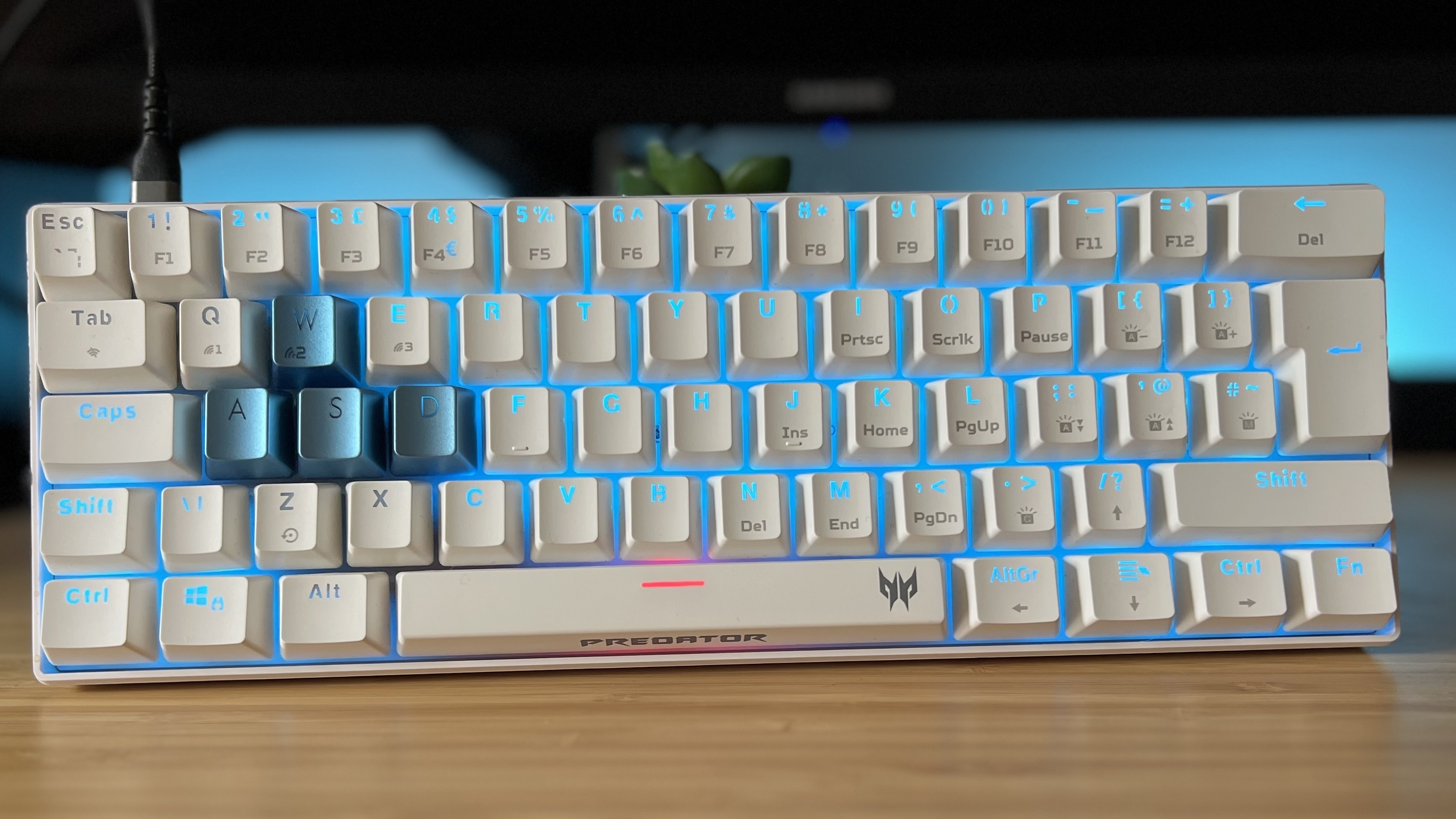
The Acer Predator Aethon 330 wants to stand out on a desk, and it does so with the help of an all-white (more cream) form factor, plenty of Predator branding, and a set of blue WASD keycaps. The actual chassis is a much crisper color than the caps themselves, which look a little dulled by comparison and pick up dust and debris particularly easily.
The aesthetic is relatively stylized by the standard of modern tastes. The Predator logo is stamped across the space key and the main legends use a stamp-like typeface that feels a little outdated.
Still, the plastic base is impressively sturdy considering the price and there’s no flex to the main top plate either. This is a well-constructed chassis in the budget price range, though you’re missing out on the sound-dampened designs of only slightly more expensive models.
The result is an incredibly loud typing experience. Clicky switches aside, there’s a significant amount of reverb and echo around the main deck area, so everyday typing is blighted by constant pinging.
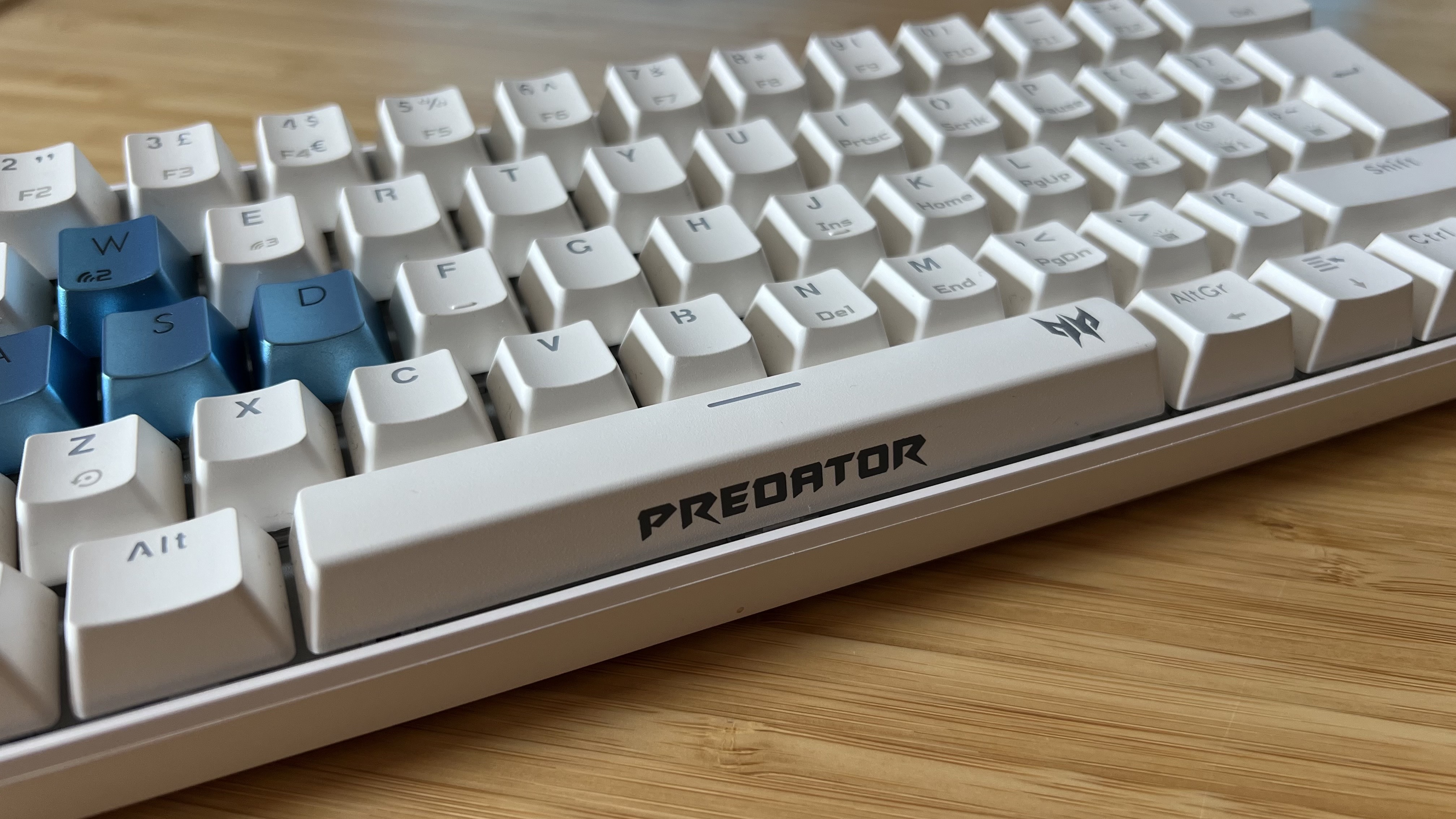
I’m glad this isn’t a simple stock black keyboard, though. The slick white chassis and sturdy build quality suggest a slightly higher price tag than some would expect from a wireless model, though it’s not the best implementation of double-function keys I’ve seen.
RGB is a big win for this deck. While some cheaper models pack lacklustre LEDs, these shine incredibly bright and manage to stay uniform even across longer legends. It’s rare to find this level of lighting power at a lower price point, so those going all-in on RGB displays will be well served.
Keycaps
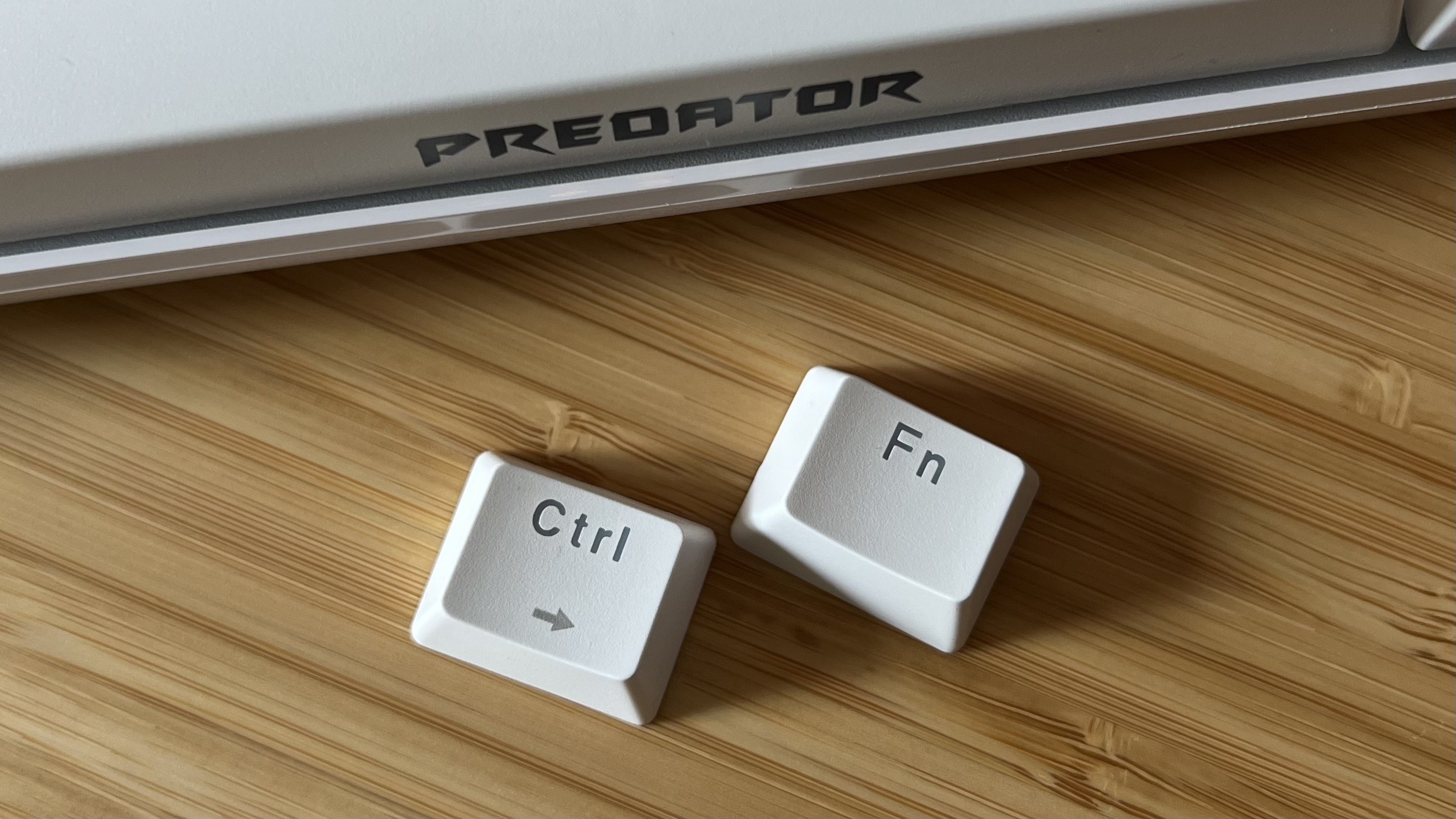
This being a smaller 60% keyboard means that pretty much every key on the right-hand side has a double-function of some kind and, with the large fonts and gray printing, things can look pretty busy. The caps themselves have the thinner construction of an ABS make but the grainy texture and doubleshot main legends more commonly associated with PBT.
I can’t find any information on the actual material used, but the surface feels like PBT under the fingertips, while holding the thinner response of ABS when actually used. The fact the caps can flex fairly easily when removed from the main deck leaves me to believe these are in fact ABS with a textured finish, though it’s an impressive implementation. They certainly feel more comfortable than the shiny, slippery keycaps I recently tested on the far more expensive Corsair K70 Pro TKL.
Switches
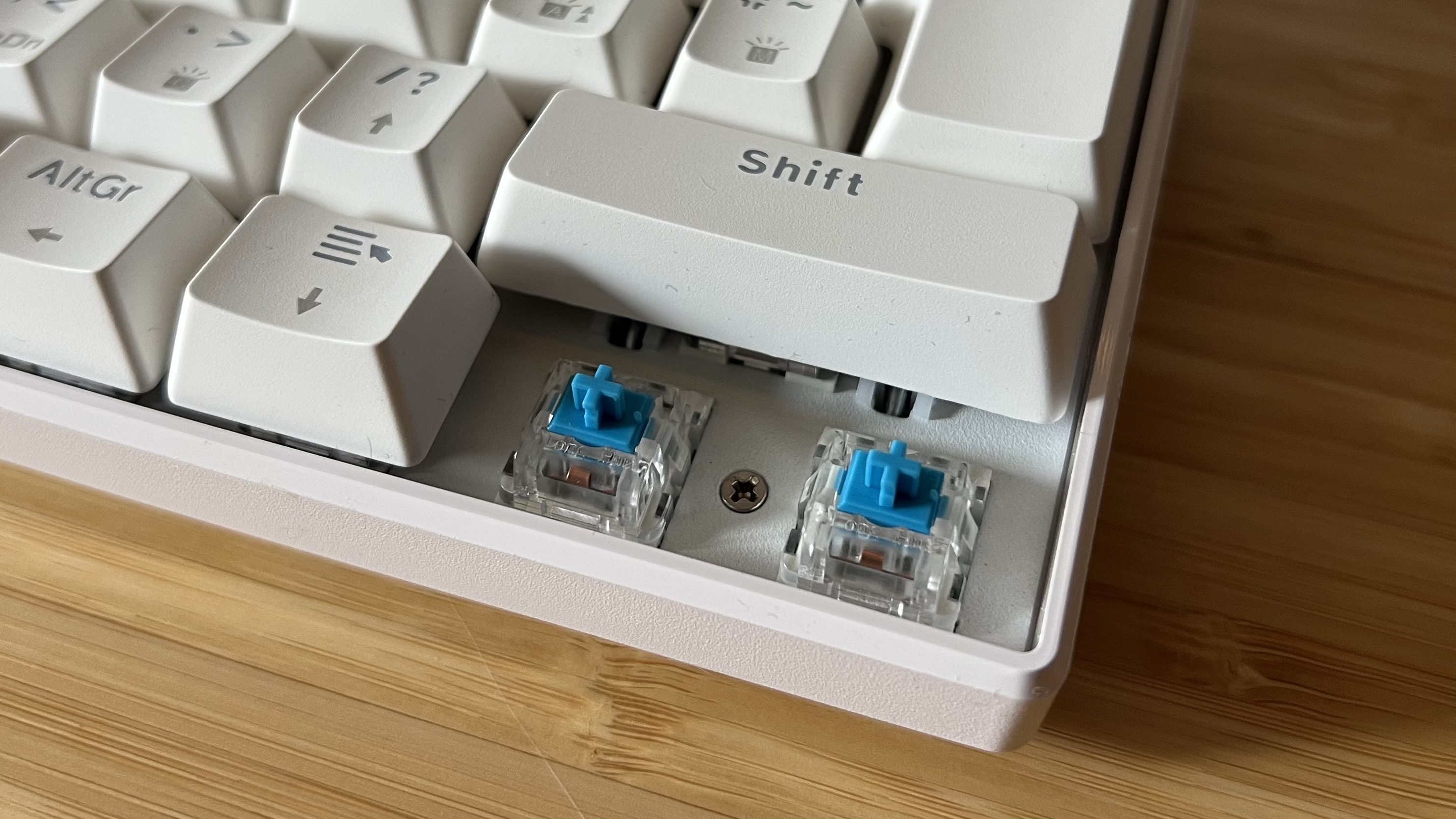
I’m not a natural fan of clicky switches, but if you don’t mind a loud typing experience and prefer as much auditory feedback as possible you won’t be put off by the Kailh Blues under these keys. The switches themselves actuate at 1.9mm with a strong tactile bump, travelling a full 4mm in total. That’s good for everyday typing, there’s no need for a forceful push here, and it’s easy to fly across keys with a much lighter tap. However, they’re far from the most satisfying clackers on the market, and certainly won’t be right for those after a deeper, thoccy experience.
In the Acer Predator Aethon 330, these switches feel particularly hollow and scratchy. With the thinner keycaps, lack of sound dampening, and softer feel, they have a lethargic bounce past the point of actuation and can feel mushy as a result.
Software
There’s no software associated with the Acer Predator Aethon 330. RGB lighting is configured directly on the board, with preset cycling available via a function layer. There’s no way to set your own keybindings with on-the-fly macro programming, and the dual-functions that are explained in the manual are only indicated with ANSI layout keys, even when shipping in ISO.
Controls
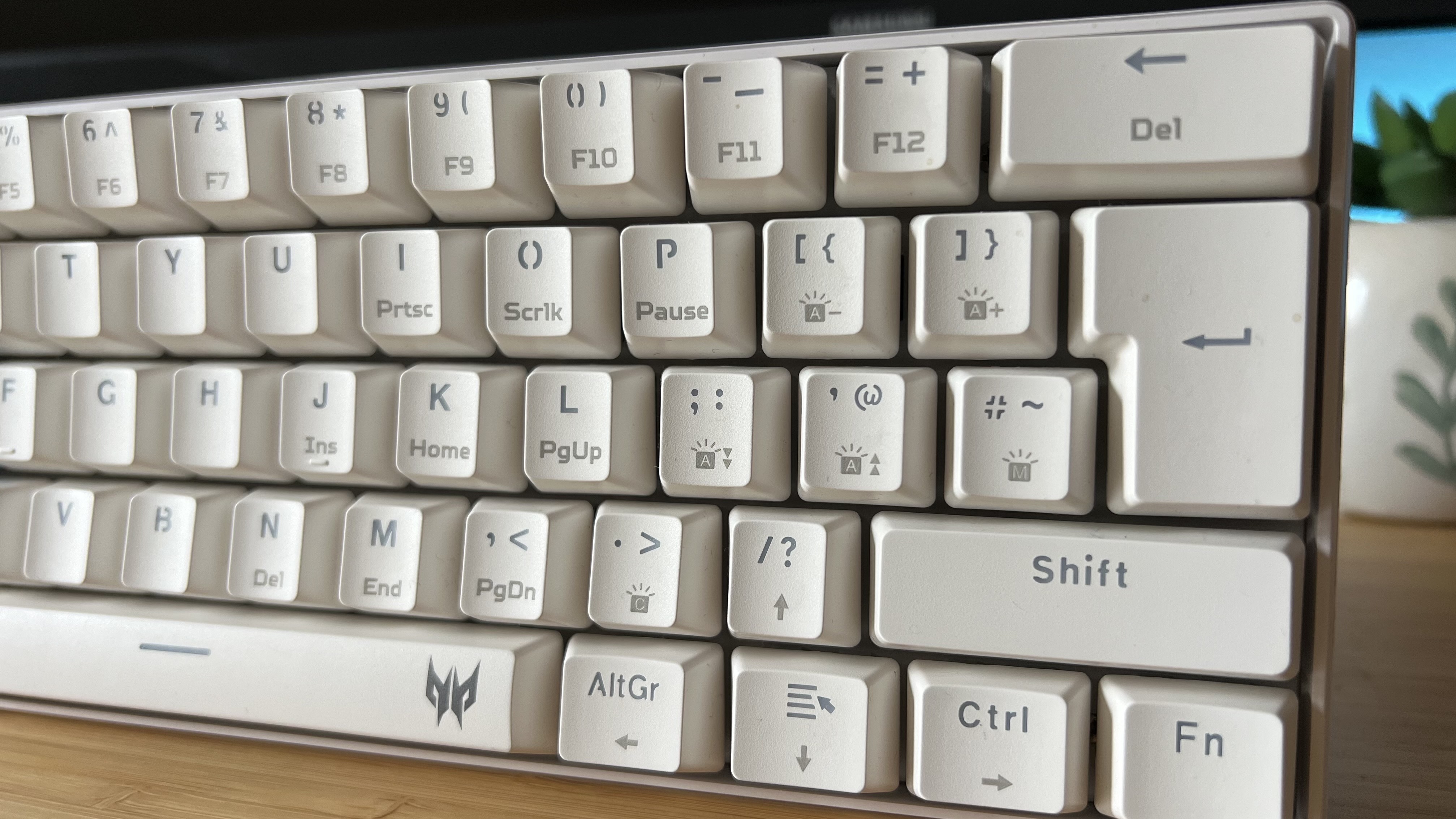
As a result of that lack of software, your onboard controls are significantly limited. Yes, this is a 60% keyboard with all the usual dual-function controls, but there’s no media control legends printed onto the deck and no mention of playback or volume settings in the manual. RGB can be shifted between 19 different settings, brightness can be raised or lowered, and speed can be shifted, but that’s about it.
I wasn’t expecting the world considering the price point, especially in the UK. However, you do get far more functionality from other brands’ budget models. While you might be more limited to wired devices, and it’s worth remembering this is only a Bluetooth connection, devices like the Razer Cynosa V2 feature full software support for macro settings as well as dedicated media controls. Even Razer’s more premium Huntsman Mini offers more functional controls in this 60% form factor, and it’s regularly available for less than the Acer Predator Aethon 330 in the US (though not in the UK).
There’s another problem here. A dual-function has been doubled up. Hitting Fn and the question mark key essentially kills your access to arrow buttons, which would usually be accessed via a secondary layer. The problem is that the question key also shares its functionality with the up arrow, which means this directional button can – essentially – never be used.
In a super fun twist, while those arrow buttons are enabled, the question mark is also out of bounds. Hitting shift and then the key simply highlights a portion of text. That’s not something I’ve ever seen before.
Connection
The Acer Predator Aethon 330 does have one trick up its sleeve that cheaper gaming keyboards in the US (and similarly priced models in the UK) don’t. That Bluetooth functionality makes it a little more versatile than the wired-only RK Royal Kludge or Redragon decks that would otherwise offer better value overall.
This is a slower connection than the 2.4GHz you’ll usually find on a gaming deck, and it’s not fast enough to keep up with the rest of the market. However, if you play slower strategy or simulation games it’s certainly enough to see you through. The Bluetooth connection was solid during my testing, though its range is limited.
Actually setting up a new connection is a little hit and miss. The onboard controls didn’t always work for me, simply flashing the RGB lighting without even pairing half the time. Once it’s all up and running, though, there’s space for three connections and an easy keybinding to switch between them on the fly. I preferred to use the 1,000Hz wired connection during most of my gameplay, though.
Battery
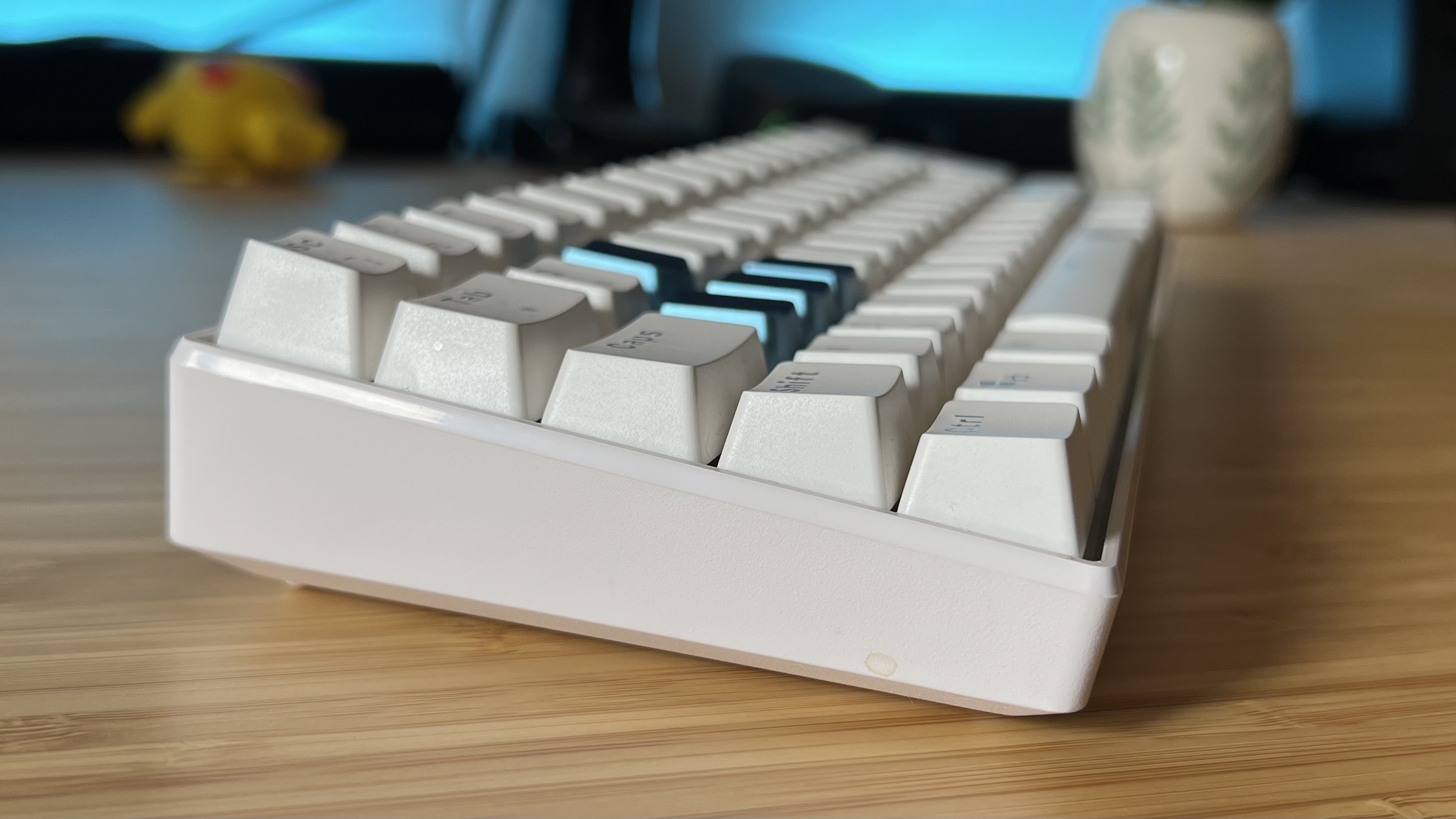
Acer doesn’t publicly state its battery life anywhere, but I managed to squeeze just under 30 hours of juice out of the device while running it without any RGB lighting. With those powerful LEDs on at full whack, I just about made it through a day of use. That’s far from competitive, while wireless gaming keyboards are generally more expensive than this, there are models only slightly above that $100 price threshold that perform much better.
The Corsair K65 Plus Wireless is only $50 more than the Acer Predator Aethon 330 is currently available for in the US, and packs a 266-hour no-RGB battery life. The Cherry MX 8.2 is $40 more in the US and I managed to get through just under a week of work and play on a single charge.
In the UK, things are a little different. The £49.99 price tag on the Aethon across the pond works particularly hard to keep it relevant. You’ll struggle to find a wireless deck from a mainstream brand for that cash, let alone one with a battery life that can compete. The Redragon K596 Pro RGB taps out at ten hours for around £60 – £70.
Typing
If you’re a clicky-switch fan you’ll enjoy the clack of these Kailh Blues under your fingertips – this switch design is favored among typists for its speed and low pressure requirements. That’s all true of the Acer Predator Aethon 330, these are low-resistance clackers that only require a slight push to actuate down to their tactile click. They’re far from the fastest on the market, and I found myself regularly dropping a press accidentally, particularly on the space bar.
Still, that speed meant the Aethon 330 kept up more expensive 60% decks like the Alienware Pro Wireless gaming keyboard and Asus ROG Falchion RX Low Profile in my typing speed test, even scoring a higher accuracy score than the heavier Alienware model.
The scratchy, mushier feel underneath that actuation point, and the louder reverb across the deck as a whole doesn’t make the overall typing experience all that pleasant. Even if you’re a fan of those clicky blue switches, there’s too much going on elsewhere around the deck to truly appreciate them. The texture of the keycaps does make skating across the deck a little more comfortable than I had initially expected, though.
Gaming
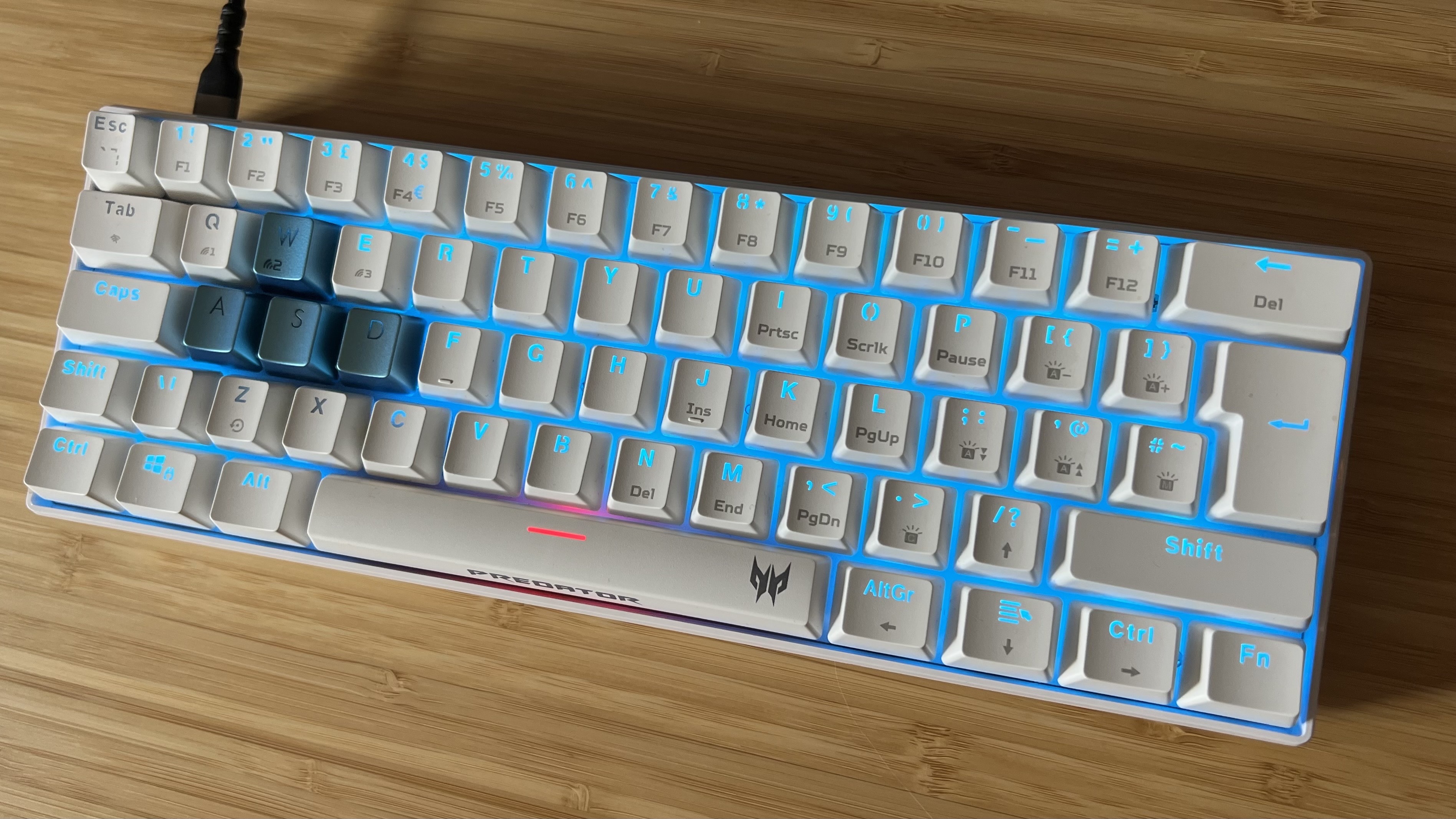
Relying on a Bluetooth connection for gaming didn’t give me the reaction speed I needed for particularly competitive endeavors, but I was able to get some good twitch-reactions in with a wired setup. Those clicky switches made for a nice, speedy approach to Apex Legends and CS:2, even if their tactile bump is a little restrictive when it comes to repeat presses.
If you’re mashing keys, you’ll want to find yourself a deck with a linear switch feel, as the actuation notch here slows down speedier hits considerably.
The lack of software-level keybinding and macro settings was a little frustrating for more complex combo moments, especially if I usually rely on a turbo-key for repeated movements in certain action-adventure titles. On the whole, though, the Acer Predator Aethon 330 functioned well in-game, with only a few missed inputs here and there. If you’re playing slower titles you’ll be fine, though anything ranked will need a more sophisticated deck.
Should you buy the Acer Predator Aethon 330?
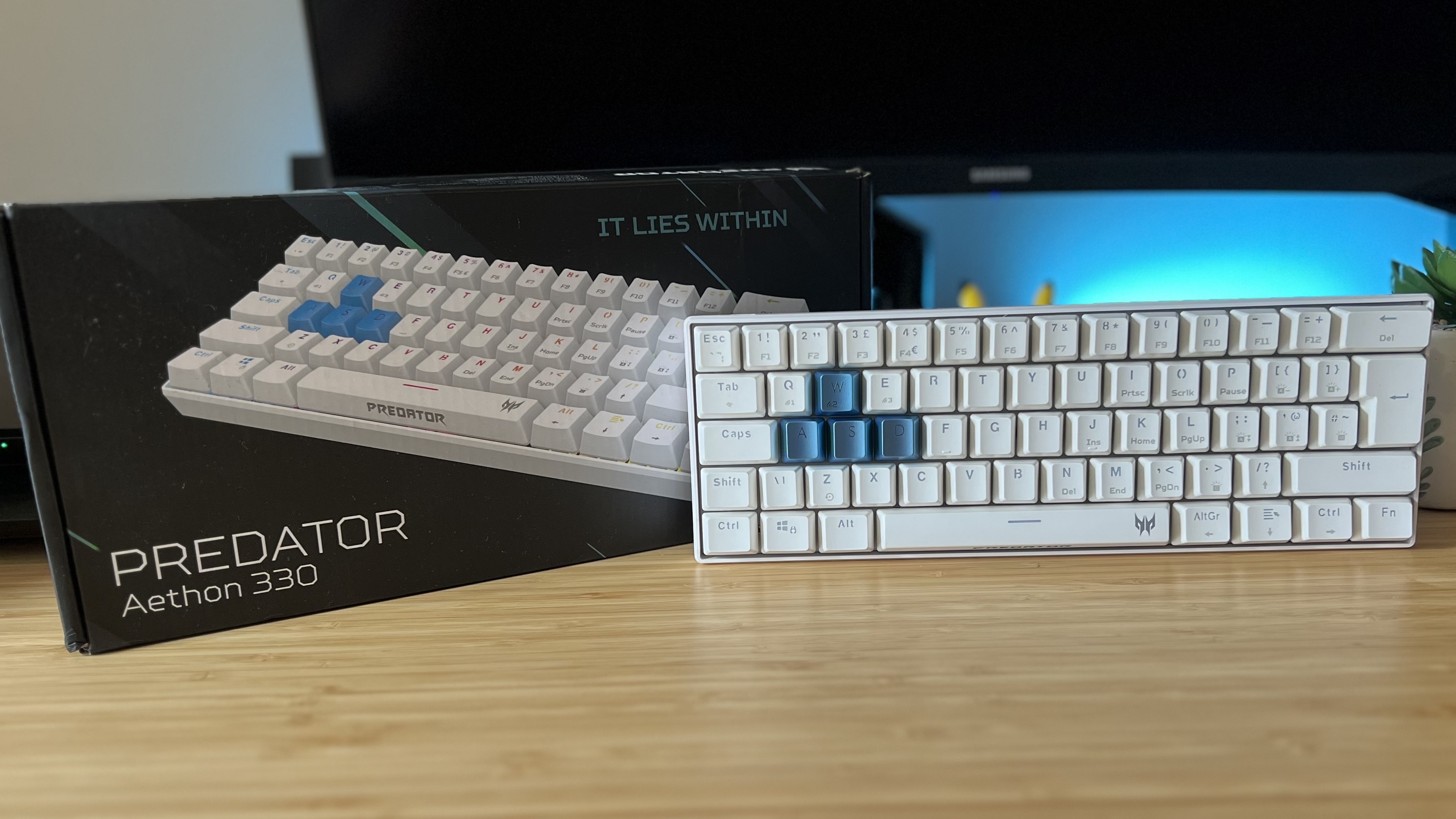
In short, probably not – especially if you’re in the US. Where the price currently sits at $99.99 the Aethon 330 doesn’t just not offer enough value against the budget wireless market, it also comes with too many control sacrifices and outright problems. There are a number of gaming keyboards only $20 – $50 more expensive than this that offer far more features, faster 2.4GHz connection speeds, and sound-dampened builds.
In the UK, things are a little more complex. The lower £49.99 price tag is certainly enticing, it’s extremely cheap for what it is – a wireless 60% gaming keyboard with solid RGB functionality. I’d still only recommend it to those who like a blue clicky switch, need to spend less than £50, and want the versatility of a Bluetooth connection for productivity purposes while still flashing those LEDs during gameplay.
|
Speed |
3/5 |
|
Customization |
2/5 |
|
Typing feel |
2/5 |
|
Portability |
3/5 |
|
Comfort |
3/5 |
|
Controls |
1/5 |
How I tested the Acer Predator Aethon 330
I used the Acer Predator Aethon 330 for all daily work and play for two weeks, testing in both Bluetooth and wired mode. I primarily used the deck for Indiana Jones and the Great Circle and South of Midnight, while performing more specific tests in Apex Legends and CS:2. I fully charged the device on unboxing and ran the battery down multiple times during this process, both with RGB lighting fully enabled and switched off. I completed three one-minute tests on TypingTest.com, taking the average score across all as my final result. For more information on how we test gaming keyboards, check out the full GamesRadar+ Hardware Policy.
I’m also hunting down all the best membrane gaming keyboards if you’re after something a little cheaper, or check out the best hot-swappable keyboards and best Razer keyboards for a larger investment.
